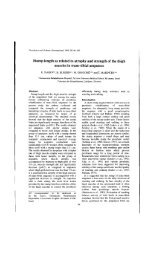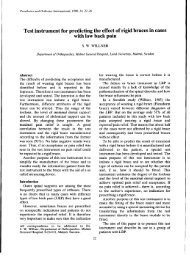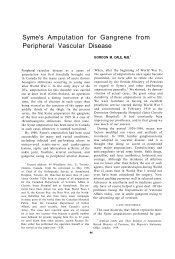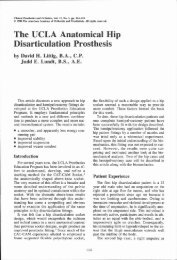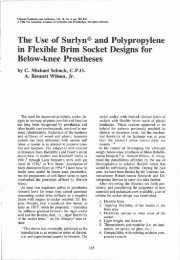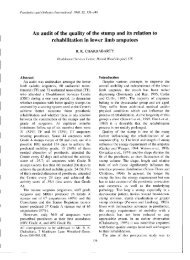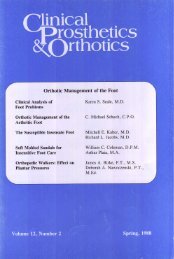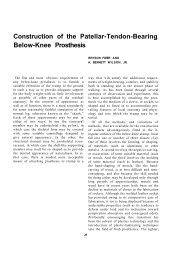The Biomechanics of Control in Upper-Extremity Prostheses
The Biomechanics of Control in Upper-Extremity Prostheses
The Biomechanics of Control in Upper-Extremity Prostheses
Create successful ePaper yourself
Turn your PDF publications into a flip-book with our unique Google optimized e-Paper software.
THE BELOW-ELBOW SOCKET<br />
<strong>The</strong> peculiar feature <strong>of</strong> the forearm, that<br />
pronation-sup<strong>in</strong>ation is a function <strong>of</strong> the whole<br />
forearm length, places a special limitation on<br />
the below-elbow socket. Although for stability<br />
<strong>in</strong> flexion the whole rema<strong>in</strong><strong>in</strong>g forearm stump<br />
is best sheathed <strong>in</strong> the socket, to do so prohibits<br />
forearm rotation. In the case <strong>of</strong> the<br />
longer below-elbow stumps, therefore, some<br />
sacrifice <strong>in</strong> stability can be afforded <strong>in</strong> the<br />
<strong>in</strong>terest <strong>of</strong> reta<strong>in</strong><strong>in</strong>g forearm rotation. <strong>The</strong><br />
proximal portion <strong>of</strong> the socket is fitted loosely<br />
to give freedom for forearm rotation while the<br />
distal portion is fitted snugly to provide a stable<br />
grip. Figure 15 shows the amount <strong>of</strong> forearm<br />
rotation available at various levels <strong>of</strong> the<br />
natural forearm and that rema<strong>in</strong><strong>in</strong>g <strong>in</strong> belowelbow<br />
amputees <strong>of</strong> various types. Because <strong>of</strong><br />
torsion <strong>of</strong> the flesh, however, and because <strong>of</strong><br />
slippage between the sk<strong>in</strong> and the socket,<br />
effective socket rotation is lost <strong>in</strong> stumps which<br />
are only 50 percent <strong>of</strong> forearm length. <strong>The</strong><br />
effective socket rotation rema<strong>in</strong><strong>in</strong>g <strong>in</strong> the<br />
wrist-disarticulation case is only about 90 deg.<br />
Further adaptations <strong>of</strong> below-elbow sockets<br />
to suit the functional requirements at the<br />
various levels are shown <strong>in</strong> Figure 16. In the<br />
long below-elbow stump, the elliptical crosssection<br />
<strong>of</strong> the forearm near the wrist permits a<br />
"screw-driver" fit <strong>of</strong> the socket to yield the<br />
Fig. 15. Below-elbow amputee types, based on average forearm<br />
length, epicondyle to styloid. After Taylor (18).<br />
BIOMECHANICS OF CONTROL 17<br />
maximum <strong>in</strong> rotational stability. With the<br />
shorter stumps, the possibility <strong>of</strong> effective<br />
rotation is reduced and is lost completely at<br />
about 50 percent <strong>of</strong> forearm length. At this<br />
level, the problem <strong>of</strong> forearm rotation is outweighed<br />
by that <strong>of</strong> provid<strong>in</strong>g flexion stability.<br />
Dependence upon a rigid or semirigid h<strong>in</strong>ge<br />
system is necessary <strong>in</strong> the short below-elbow<br />
stump, and f<strong>in</strong>ally, <strong>in</strong> the very short stump,<br />
effective forearm flexion is so reduced that a<br />
split socket with step-up h<strong>in</strong>ge becomes a<br />
necessity.<br />
<strong>The</strong> goal <strong>of</strong> below-elbow socket design is to<br />
rega<strong>in</strong> as completely as possible the control<br />
function <strong>of</strong> the forearm, which <strong>in</strong>cludes (a)<br />
position<strong>in</strong>g <strong>of</strong> the hand by forearm flexion and<br />
(b) hand rotation by means <strong>of</strong> pronationsup<strong>in</strong>ation.<br />
In the below-elbow prosthesis,<br />
adequate forearm flexion is obta<strong>in</strong>ed rather<br />
easily; rotation is limited to the potential<br />
available <strong>in</strong> the longer stumps. Manual wrist<br />
rotation, <strong>of</strong> course, supplements the rema<strong>in</strong><strong>in</strong>g<br />
natural rotation. In the below-elbow prosthesis,<br />
then, control <strong>of</strong> the term<strong>in</strong>al device <strong>in</strong><br />
space depends <strong>in</strong> fair measure upon the role <strong>of</strong><br />
the socket <strong>in</strong> preserv<strong>in</strong>g the residual flexion<br />
and rotation <strong>of</strong> the below-elbow stump.<br />
THE ABOVE-ELBOW SOCKET<br />
Unlike the below-elbow case, the aboveelbow<br />
stump presents no problem <strong>of</strong> dim<strong>in</strong>ish<strong>in</strong>g<br />
rotation with dim<strong>in</strong>ish<strong>in</strong>g<br />
stump length because arm rotation<br />
is conf<strong>in</strong>ed wholly to the glenohumeral<br />
jo<strong>in</strong>t. Socket design for<br />
the above-elbow case is therefore<br />
related pr<strong>in</strong>cipally to the requirement<br />
<strong>of</strong> fitt<strong>in</strong>g the stump closely<br />
so that the humeral lever can be<br />
fully effective <strong>in</strong> controll<strong>in</strong>g the<br />
prosthesis. Figure 17 shows the<br />
m<strong>in</strong>or variations correspond<strong>in</strong>g to<br />
above-elbow type, <strong>in</strong>clud<strong>in</strong>g the elbow<br />
disarticulation. Sockets for the<br />
latter must take account <strong>of</strong> the<br />
bulbous end <strong>of</strong> the stump. <strong>The</strong>y<br />
must provide snug fit around the<br />
epicondyle projections but ma<strong>in</strong>ta<strong>in</strong><br />
sufficient room <strong>in</strong> the region<br />
just above, where the stump<br />
cross-section is reduced, to permit



